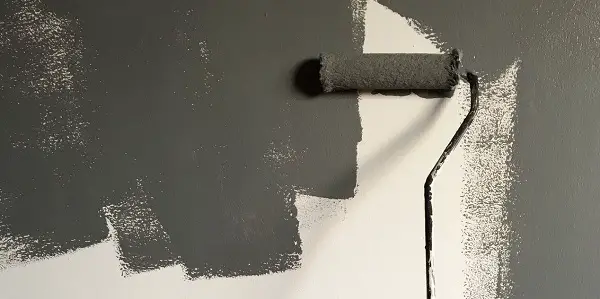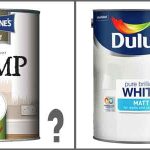The DIY Fix is reader supported. When you buy after clicking a link on our site, we may earn an affiliate commission.
In this article we will be looking at whether you can paint over damp proof paint with a standard emulsion. We will also look at when this is a good solution, and when it might not work that well.

Damp caused by excess moisture, is a very common problem in properties throughout the UK. This can lead to unsightly stains and damage to decorating. As well as create mould and mildew, which can be harmful to health. For this reason, you should try to eliminate damp as soon as you find it and prevent it from returning in the future.
Damp proof paint offers a highly effective solution to dealing with damp on internal walls. Once applied it can provide years of protection against damp and mould returning.
So, can you paint over damp proof paint?
Yes, damp proof paints can be painted over and be just as effective. In fact, most of the time, this is the best option, especially if you want to paint your walls in specific colours. Most damp proof paints are designed for general use around the house and will usually come in white.
The majority of damp proof paints offer a one coat solution. This can be used as a first coat to add a damp proof layer. Following this you can paint over with a standard emulsion. You could also choose to wallpaper over the area.
One exception to this, are damp proof paints designed for damp bathrooms. Bathroom paints tend to come in a wider range of colours. These paints are usually intended as a finished coat and are specifically designed to deal with high moisture in bathrooms. A good example of this would be Dulux easy care bathroom paint.
When is damp proof paint not a good solution?
Damp proof paint can be extremely effective for preventing damp and mould. However, it is not the solution to all damp problems. It is usually best suited for preventing damp, which is caused inside the home, such as condensation damp.
It can also be very useful for covering up stains that have been caused by other forms of damp. Such as penetrating damp, or rising damp.
With that said, both penetrating damp and rising damp cannot be treated with damp proof paint. Instead, you will need to solve these issues before you redecorate with a damp proof paint. Simply painting over serious damp issues like these, will just result in the damp returning later.
However, once these more serious types of damp have been fixed. Using a damp proof paint or an anti mould paint, can be an excellent way of covering stains and preventing mould and mildew from forming in the future.
You can read our complete guide to identifying and fixing penetrating damp here
You can also learn more about rising damp and how this can be fixed here
Damp proof paints contain a water reactive agent. This stops moisture from soaking into your walls, but it is also highly breathable. Due to this, trapped moisture can easily escape, which means water cannot soak in and cause mould. Many damp proofing paints also contain anti mould formulas. This adds extra protection to prevent mould from forming.
How soon can you paint over damp proof paint?
Once you have applied a damp proof paint. You should be ready to add your next coat of standard emulsion, after around 4-6 hours. This will vary with different brands, but you can start to paint over the damp proofing layer of paint as soon as it is dry to the touch.
Most damp proof paints claim to be one coat. However, there are certain instances where a second coat will be required. You will need to check if you achieved a complete coverage with your first coat. If the coat is thin or patchy, it is recommended to add a second coat.
This will make sure that your damp proof paint is evenly applied. Which will add an even layer of protection and provide a better finish once an emulsion is finally applied.
If you do add two coats, the second can usually be added 4-6 hours after the first. Again, the surface should be dry to the touch before proceeding with your second coat. Once the second coat is dry you can add your standard emulsion to finish.
Preparation for the best results
As with any decorating job, preparation is key. Before you apply your damp proof paint, you should ensure that the surface is completely clean and clear of any dust, dirt, or any other imperfections.
This can be achieved, by scraping previous paint and wallpaper from the surface and sanding them down, to create a smooth area to paint on.
Most damp proof paints will claim you can paint straight on to a damp surface. Whilst this is true, it is still recommended to try and make the surface as dry as possible. To do this you can do the following:
- Wipe down to remove surface moisture
- Turn on the central heating, extra heat will allow excess moisture to evaporate
- Improve ventilation and air circulation. This will remove moisture in the air and can be achieved by opening windows and doors, using a standard fan to help air circulate, or using an extractor fan.
- Finally, you can use a good dehumidifier that will extract water from the air.
You should also make sure that all existing mould and mildew is removed from the surface. Painting over mould will not kill it and the mould will soon reappear. You will need to remove and completely kill any remaining spores. This will mean once the wall is painted, the mould will have no chance of re-growing.
The best way to remove and kill mould is with an effective mould remover. You can pick these up for a couple of pounds. And they will completely remove mould. It’s quite impressive to watch.
Our favourite mould remover here at thedampbuster.com is Cilit Bang Black Mould Remover. You can learn more about this on Amazon and read hundreds of reviews by clicking here.
Conclusion
Damp proofing paint can be painted over with any standard paint. Once you have added an emulsion over the top, the damp proof paint will be just as effective.
The key thing to remember, is preparation. If you want to achieve the best possible finish, you need to make sure the surface is thoroughly prepared before adding any coat of paint. This will include removing any imperfections, filling cracks and holes, removing dust and dirt. Plus, trying to get the wall relatively dry, and completely mould free.
If you would like to read more and discover our top rated damp proof paints, click here


